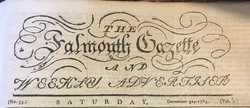
Map of the Inhabited Part of Maine, Moses Greenleaf, 1829
Maine Historical Society
Many know that the Missouri Compromise brought Maine into the Union as a free state in 1820, allowing politicians in Washington to delay a growing sectional crisis over the future of slavery. Yet Maine's push for separation from Massachusetts did not begin in 1820, nor was it simply dictated by Congress. Since the founding of the United States, a consistent and longstanding local fight for independence had been underway and was steered by savvy leaders, mercantile pursuits, boundary fights and much more.
Before it achieved statehood, the District of Maine was a territory of the Commonwealth of Massachusetts. While indigenous tribes resided in areas across the region for centuries before, Maine was settled by Europeans in the first half of the 17th century and was gradually absorbed by Massachusetts land claims beginning in 1651. Maine's population grew over the next century, particularly in coastal towns. After the American Revolution achieved independence for the United States, the District still had no autonomous legislature or executive, but instead sent delegates from incorporated towns to the Massachusetts General Court. Despite having some political voice, a growing faction of the District's populace felt unrepresented and burdened by the distant government in Boston.
As whispers of separation became louder in the late 1700s, various political grievances began to dominate the growing debate. On the coast, commercial traders felt bound to Massachusetts because of otherwise inconvenient shipping laws, and a growing inland debate ensued over tension between land proprietors and squatters who saw independence as a method to obtain their own land. Additionally, towns in York County sought to remain part of Massachusetts because of their close proximity to Boston, while towns across the District felt that they were susceptible to attack from the British troops in Canada without the protection of Massachusetts. As we will see, by the time statehood became a plausible reality, much of the debate over separation fell along party lines, with Republicans (Jeffersonians) supporting an independent Maine and the minority Federalists making up the opposition.


The Falmouth Gazette and Weekly AdvertiserThe Falmouth Gazette—the District of Maine's first newspaper—was founded by fervent separationists and became instrumental in the early push for an independent Maine.
Throughout this period, separationists, anti-separationists and the press consistently debated the question of an independent Maine. Each effort made asked one fundamental question: Is this really the right time to separate? The answers often depended on the District's position within state and national affairs, and at times became contentious and highly controversial. Between 1792 and 1819 there were six separate elections for separation submitted to the General Court, and more that did not receive enough ballots to be deemed legitimate. Finally, in 1820, Maine received its statehood under the Missouri Compromise—but this did not come without a moral dilemma, and deep ethical infighting from the separation movement's leadership.
Header image, detail of A Map of the State of Maine (1820) by Moses Greenleaf. Contributed by Osher Map Library and Smith Center for Cartographic Education.